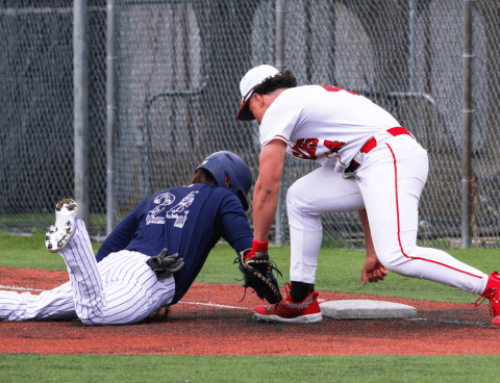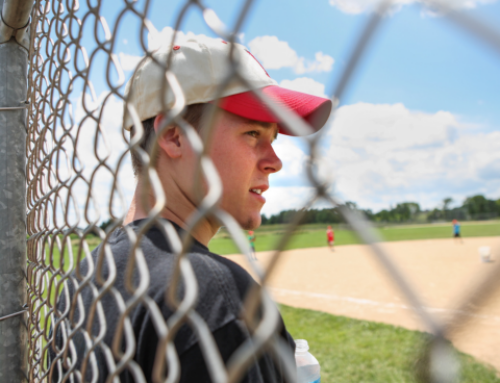Strength Endurance Training With Justin Upton
Some athletes settle for fluke feats. Legends seek and sustain excellence.
Athletic greatness is measured by an individual’s ability to perform at the highest level and consistently record impressive feats. Likewise, strength endurance is characterized by an athlete’s ability to fire his muscles powerfully and effectively in a repeated fashion over an extended period of time.
For the Arizona Diamondbacks’ Justin Upton, strength endurance training and baseball are a perfect match.
The power-hitting corner outfielder generates tremendous bat speed, and he has the ability to drive the ball to all fields. Yes, the 23-year-old is supremely talented, but the strength endurance he developed during the off-season plays a Major League role in his perennial prowess at the plate.
Justin’s off-season goal is to get back into “baseball shape,” and his training program covers more ground than his spray chart. The workout isn’t easy, but neither is baseball. Justin’s up on it, because he knows that strength endurance training and conditioning are aspects of his game that he can control.
Conditioning and strength endurance are perhaps the least favorite elements for athletes to train, yet they are the primary areas of focus during the young slugger’s workouts. “It’s not fun,” Justin admits. “Afterwards, it’s fun, once you get it done and you know you busted it and that you gave everything you had that day. It’s the perfect day for me.”
The bulk of the workout is performed in a single-set-to-failure fashion, which means taking the muscle to complete exhaustion during one set—hit it and quit it. “Some athletes may need multiple sets because they’re not willing to push themselves,” says Denny Locascio, performance enhancement specialist for Sports and Field in Wesley Chapel, Fla., Upton’s off-season training home. “Justin is willing to push himself that hard, and he only needs one set.”
Keeping the muscles loaded throughout the duration of the set—whether it’s a 10-count hold or 60-second set—makes the training even more demanding and helps strengthen the muscles around the major joints. The goal is to keep Justin on the field and injury-free, performing at 100 percent for 160-plus games a year.
Being Justin Upton
Justin’s motivation to outwork others comes as no surprise. For much of his young career, he followed in others’ footsteps, trying to fit into the big shoes he was summoned to fill. Like other Little Leaguers growing up in the ’90s, he could usually be found in the front yard of his family home (in Chesapeake, Va.), “turning around left-handed and hitting like [Ken] Griffey.”
The top ballplayer in the neighborhood was a slender second baseman who was three years and four days older than Justin—his brother B.J. The younger Upton always held the short end of the stick when battling his brother. “He was always a step up, a step better. He always beat up on me,” Justin recalls.
The sibling rivalry inspired Justin early in his career. “I wanted to push to get to the next level [B.J.] went to,” Justin says. “Looking up to him and [watching] him progress and get to where he was made me work harder.”
Justin’s hard work produced success, and with it even higher expectations. He could never escape being compared to B.J., who was selected second overall in the 2002 MLB Draft by the Tampa Bay Rays. But as Justin’s game grew, his name started being mentioned in the same breath as one of the most prolific power hitters in baseball, Ken Griffey Jr.
Fact or coincidence? There were too many connections to ignore: both were first overall MLB Draft selections as 17-year-old high school grads. “The Kid” was drafted in 1987, less than two months before Justin was born, and both made their highly-anticipated MLB debuts at the age of 19.
That’s all fun for Justin, but the All-Star right fielder no longer measures himself against B.J., nor does he hope to become the next Ken Griffey Jr. “I want to be my own guy and make my own name,” he says. “I’m trying to be Justin Upton now.”
When Justin’s ready to push the limits, he takes the field for a series of dynamic stretches and movements, followed by speed ladder work. After a punishing conditioning circuit, he steps up to the plate, hitting a series of nine strength endurance-building lifts.
Watch video of Justin Upton’s training progression from high school to the Major Leagues.
Conditioning Gauntlet
- Line up six cones five yards apart
- Starting at cone 1, shuffle to cone 2; plant and sprint back to cone 1
- Repeat to each cone
- Repeat Gauntlet using Carioca-to-Sprint, Backpedal-to-Sprint and Sprint-to-Sprint patterns
Sets/Reps: 1×4 with 2 minutes rest
Coaching Points: Maintain proper form // Don’t cheat; cover the full distance from cone to cone
Leg Press
- On Leg Press machine, place feet shoulder-width apart
- Lower weight with control using four-count negative, bringing knees to chest
- Drive weight up by extending legs to start position for two-count contraction; repeat
- Rest 10 seconds and repeat next set
Sets/Reps: 1×6, 1×5, 1×4, 1×3, 1×2, 1×1
Coaching Points: Use light weight // Use full range of motion // Don’t bounce weight at bottom of movement
Hip Adduction
- On Seated Adductor machine, bring legs together; hold for count
- Return to start position
- Finish with 10-count hold with legs together and 10-count hold at full stretch for final rep
Sets/Reps: 1×12
Coaching Points: Perform in slow, controlled manner // Use full range of motion
Leg Curl With Negative
- On Leg Curl machine, contract hamstrings to bring heels to butt; hold for one count
- Lower weight with control using 10-count negative until legs are straight
Sets/Reps: 3×10
Coaching Point: Don’t pause or allow weight to touch at bottom of movement
Leg Extension
- On Leg Extension machine, raise weight until legs are fully extended for two-count contraction; hold for one count
- Lower weight with control using four-count negative until knees are bent almost at a 90-degree angle; repeat
Sets/Reps: 30 reps in 3 sets or less with 30 seconds rest
Coaching Point: Don’t allow weight to touch at bottom of movement
Hammer Pulldown
- On Hammer Strength Pulldown machine, grasp handles with palms facing slightly inward
- Pull handles to chest using two-count contraction; hold for one count
- Return to start position using four-count negative; repeat
Sets/Duration: 1×60 seconds
Coaching Points: Don’t use momentum to pull weight // Keep chest pressed against pad // Get full stretch at top of movement
Chest Fly
- On Chest Fly machine, drive arms inward to midline of body using two-count contraction
- Return to start position using four-count negative; repeat
Sets/Duration: 1×60 seconds
Coaching Point: Use full range of motion
Dumbbell Row
- Place right hand and right knee on bench and left leg on floor to side
- Hold dumbbell in left hand with palm facing inward
- Bring dumbbell to chest while keeping elbow tight to body; hold for one count
- Lower dumbbell to start position; repeat
- Perform on opposite side
Sets/Reps: 1×10 each arm
Coaching Points: Fully extend arm at bottom of movement // Keep back straight // Perform slowly without any side-to-side body movement
Machine Shoulder Press
- Grasp handles at shoulder level with palms facing inward
- Drive weight up using two-count contraction until arms are straight; hold for one count
- Lower weight to start position using four-count negative; repeat
Sets/Duration: 1×60 seconds
Coaching Points: Use full range of motion // Don’t use momentum to drive weight // Keep low back flat against pad
Machine Rear Delt
- On Rear Delt machine, drive arms out using two-count contraction; hold for one count
- Return to start position using four-count negative; repeat
Sets/Duration: 1×60 seconds
Coaching Points: Use full range of motion // Bring arms together in front
RECOMMENDED FOR YOU
MOST POPULAR
Strength Endurance Training With Justin Upton
Some athletes settle for fluke feats. Legends seek and sustain excellence.
Athletic greatness is measured by an individual’s ability to perform at the highest level and consistently record impressive feats. Likewise, strength endurance is characterized by an athlete’s ability to fire his muscles powerfully and effectively in a repeated fashion over an extended period of time.
For the Arizona Diamondbacks’ Justin Upton, strength endurance training and baseball are a perfect match.
The power-hitting corner outfielder generates tremendous bat speed, and he has the ability to drive the ball to all fields. Yes, the 23-year-old is supremely talented, but the strength endurance he developed during the off-season plays a Major League role in his perennial prowess at the plate.
Justin’s off-season goal is to get back into “baseball shape,” and his training program covers more ground than his spray chart. The workout isn’t easy, but neither is baseball. Justin’s up on it, because he knows that strength endurance training and conditioning are aspects of his game that he can control.
Conditioning and strength endurance are perhaps the least favorite elements for athletes to train, yet they are the primary areas of focus during the young slugger’s workouts. “It’s not fun,” Justin admits. “Afterwards, it’s fun, once you get it done and you know you busted it and that you gave everything you had that day. It’s the perfect day for me.”
The bulk of the workout is performed in a single-set-to-failure fashion, which means taking the muscle to complete exhaustion during one set—hit it and quit it. “Some athletes may need multiple sets because they’re not willing to push themselves,” says Denny Locascio, performance enhancement specialist for Sports and Field in Wesley Chapel, Fla., Upton’s off-season training home. “Justin is willing to push himself that hard, and he only needs one set.”
Keeping the muscles loaded throughout the duration of the set—whether it’s a 10-count hold or 60-second set—makes the training even more demanding and helps strengthen the muscles around the major joints. The goal is to keep Justin on the field and injury-free, performing at 100 percent for 160-plus games a year.
Being Justin Upton
Justin’s motivation to outwork others comes as no surprise. For much of his young career, he followed in others’ footsteps, trying to fit into the big shoes he was summoned to fill. Like other Little Leaguers growing up in the ’90s, he could usually be found in the front yard of his family home (in Chesapeake, Va.), “turning around left-handed and hitting like [Ken] Griffey.”
The top ballplayer in the neighborhood was a slender second baseman who was three years and four days older than Justin—his brother B.J. The younger Upton always held the short end of the stick when battling his brother. “He was always a step up, a step better. He always beat up on me,” Justin recalls.
The sibling rivalry inspired Justin early in his career. “I wanted to push to get to the next level [B.J.] went to,” Justin says. “Looking up to him and [watching] him progress and get to where he was made me work harder.”
Justin’s hard work produced success, and with it even higher expectations. He could never escape being compared to B.J., who was selected second overall in the 2002 MLB Draft by the Tampa Bay Rays. But as Justin’s game grew, his name started being mentioned in the same breath as one of the most prolific power hitters in baseball, Ken Griffey Jr.
Fact or coincidence? There were too many connections to ignore: both were first overall MLB Draft selections as 17-year-old high school grads. “The Kid” was drafted in 1987, less than two months before Justin was born, and both made their highly-anticipated MLB debuts at the age of 19.
That’s all fun for Justin, but the All-Star right fielder no longer measures himself against B.J., nor does he hope to become the next Ken Griffey Jr. “I want to be my own guy and make my own name,” he says. “I’m trying to be Justin Upton now.”
When Justin’s ready to push the limits, he takes the field for a series of dynamic stretches and movements, followed by speed ladder work. After a punishing conditioning circuit, he steps up to the plate, hitting a series of nine strength endurance-building lifts.
Watch video of Justin Upton’s training progression from high school to the Major Leagues.
Conditioning Gauntlet
- Line up six cones five yards apart
- Starting at cone 1, shuffle to cone 2; plant and sprint back to cone 1
- Repeat to each cone
- Repeat Gauntlet using Carioca-to-Sprint, Backpedal-to-Sprint and Sprint-to-Sprint patterns
Sets/Reps: 1×4 with 2 minutes rest
Coaching Points: Maintain proper form // Don’t cheat; cover the full distance from cone to cone
Leg Press
- On Leg Press machine, place feet shoulder-width apart
- Lower weight with control using four-count negative, bringing knees to chest
- Drive weight up by extending legs to start position for two-count contraction; repeat
- Rest 10 seconds and repeat next set
Sets/Reps: 1×6, 1×5, 1×4, 1×3, 1×2, 1×1
Coaching Points: Use light weight // Use full range of motion // Don’t bounce weight at bottom of movement
Hip Adduction
- On Seated Adductor machine, bring legs together; hold for count
- Return to start position
- Finish with 10-count hold with legs together and 10-count hold at full stretch for final rep
Sets/Reps: 1×12
Coaching Points: Perform in slow, controlled manner // Use full range of motion
Leg Curl With Negative
- On Leg Curl machine, contract hamstrings to bring heels to butt; hold for one count
- Lower weight with control using 10-count negative until legs are straight
Sets/Reps: 3×10
Coaching Point: Don’t pause or allow weight to touch at bottom of movement
Leg Extension
- On Leg Extension machine, raise weight until legs are fully extended for two-count contraction; hold for one count
- Lower weight with control using four-count negative until knees are bent almost at a 90-degree angle; repeat
Sets/Reps: 30 reps in 3 sets or less with 30 seconds rest
Coaching Point: Don’t allow weight to touch at bottom of movement
Hammer Pulldown
- On Hammer Strength Pulldown machine, grasp handles with palms facing slightly inward
- Pull handles to chest using two-count contraction; hold for one count
- Return to start position using four-count negative; repeat
Sets/Duration: 1×60 seconds
Coaching Points: Don’t use momentum to pull weight // Keep chest pressed against pad // Get full stretch at top of movement
Chest Fly
- On Chest Fly machine, drive arms inward to midline of body using two-count contraction
- Return to start position using four-count negative; repeat
Sets/Duration: 1×60 seconds
Coaching Point: Use full range of motion
Dumbbell Row
- Place right hand and right knee on bench and left leg on floor to side
- Hold dumbbell in left hand with palm facing inward
- Bring dumbbell to chest while keeping elbow tight to body; hold for one count
- Lower dumbbell to start position; repeat
- Perform on opposite side
Sets/Reps: 1×10 each arm
Coaching Points: Fully extend arm at bottom of movement // Keep back straight // Perform slowly without any side-to-side body movement
Machine Shoulder Press
- Grasp handles at shoulder level with palms facing inward
- Drive weight up using two-count contraction until arms are straight; hold for one count
- Lower weight to start position using four-count negative; repeat
Sets/Duration: 1×60 seconds
Coaching Points: Use full range of motion // Don’t use momentum to drive weight // Keep low back flat against pad
Machine Rear Delt
- On Rear Delt machine, drive arms out using two-count contraction; hold for one count
- Return to start position using four-count negative; repeat
Sets/Duration: 1×60 seconds
Coaching Points: Use full range of motion // Bring arms together in front











